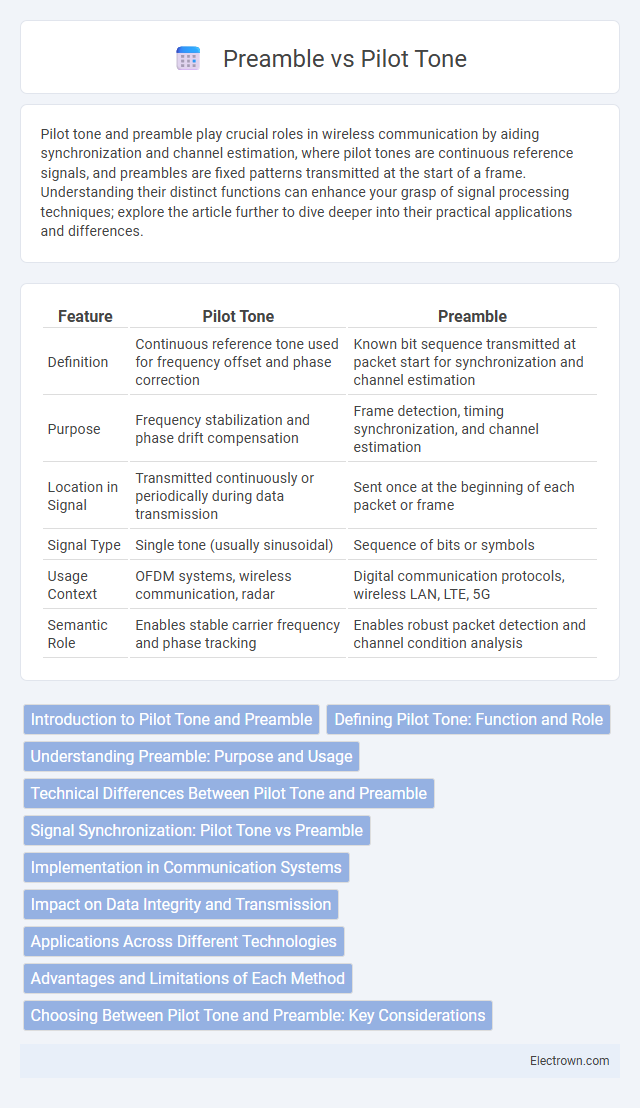Pilot tone and preamble play crucial roles in wireless communication by aiding synchronization and channel estimation, where pilot tones are continuous reference signals, and preambles are fixed patterns transmitted at the start of a frame. Understanding their distinct functions can enhance your grasp of signal processing techniques; explore the article further to dive deeper into their practical applications and differences.
Table of Comparison
| Feature | Pilot Tone | Preamble |
|---|---|---|
| Definition | Continuous reference tone used for frequency offset and phase correction | Known bit sequence transmitted at packet start for synchronization and channel estimation |
| Purpose | Frequency stabilization and phase drift compensation | Frame detection, timing synchronization, and channel estimation |
| Location in Signal | Transmitted continuously or periodically during data transmission | Sent once at the beginning of each packet or frame |
| Signal Type | Single tone (usually sinusoidal) | Sequence of bits or symbols |
| Usage Context | OFDM systems, wireless communication, radar | Digital communication protocols, wireless LAN, LTE, 5G |
| Semantic Role | Enables stable carrier frequency and phase tracking | Enables robust packet detection and channel condition analysis |
Introduction to Pilot Tone and Preamble
Pilot tone is a continuous reference signal transmitted alongside data to assist in synchronization and channel estimation in wireless communication systems. Preamble consists of a known sequence of bits sent at the beginning of a data packet to enable receiver timing acquisition, frequency offset correction, and frame synchronization. Both pilot tone and preamble play crucial roles in enhancing signal integrity and decoding accuracy in digital communication protocols.
Defining Pilot Tone: Function and Role
Pilot tone serves as a reference signal in communication systems, enabling synchronization and accurate demodulation of transmitted data. It helps your receiver maintain frequency and phase alignment, reducing errors caused by channel impairments. Unlike the preamble, which primarily signals the start of a packet, the pilot tone continuously supports signal integrity throughout transmission.
Understanding Preamble: Purpose and Usage
The preamble in digital communication serves as a vital synchronization sequence that enables receivers to identify the start of a data packet and align timing for accurate data decoding. It consists of a predefined bit pattern that facilitates channel estimation and timing recovery, ensuring reliable signal interpretation. Understanding the preamble's role enhances system performance by reducing errors and optimizing data throughput in wireless and wired communication protocols.
Technical Differences Between Pilot Tone and Preamble
The pilot tone is a continuous reference signal transmitted alongside data to aid in carrier synchronization and frequency offset correction, while the preamble is a distinct, known bit sequence sent at the start of a frame to facilitate frame synchronization and channel estimation. Pilot tones typically operate at a specific, narrowband frequency and are embedded within the transmission for real-time tracking, whereas preambles encompass a broader sequence of bits used for initial receiver alignment before data decoding. The technical difference lies in the pilot tone's role in maintaining ongoing synchronization during transmission, compared to the preamble's function as a one-time synchronization and channel characterization pattern prior to payload reception.
Signal Synchronization: Pilot Tone vs Preamble
Pilot tones and preambles are critical for signal synchronization in wireless communication systems, but they function differently. Pilot tones provide continuous reference signals that enable accurate carrier frequency and phase synchronization, improving demodulation robustness in fading channels. Preambles, on the other hand, are predefined sequences transmitted at the start of a packet, allowing receivers to detect frame boundaries and perform time synchronization before data decoding begins.
Implementation in Communication Systems
Pilot Tone and Preamble are fundamental components in communication systems that facilitate synchronization and channel estimation. Pilot Tone involves continuous or periodic insertion of a known frequency tone to assist in frequency and phase tracking during signal demodulation. Preamble consists of a predefined sequence of bits transmitted at the beginning of a frame, enabling receiver synchronization, frame detection, and channel estimation for accurate data decoding.
Impact on Data Integrity and Transmission
Pilot Tone enhances data integrity by continuously providing a stable reference signal that helps in accurate frequency synchronization during transmission. Preamble, consisting of a known bit sequence, enables your receiver to identify the start of a data packet, facilitating proper timing alignment and error detection. Both methods improve transmission reliability but Pilot Tone offers real-time correction, which is crucial for maintaining consistent data quality in noisy environments.
Applications Across Different Technologies
Pilot tone and preamble serve critical roles across communication technologies; pilot tones are widely used in analog and digital radio to facilitate carrier synchronization and frequency correction, especially in FM broadcasting and satellite communication systems. Preambles are crucial in wireless networking protocols such as Wi-Fi and Ethernet, providing devices with the necessary timing and framing information for data packet synchronization and error detection. Both techniques enhance signal reliability but apply to different layers of communication, with pilot tones primarily addressing physical layer carrier stability and preambles ensuring accurate data transmission at the data link layer.
Advantages and Limitations of Each Method
Pilot tone offers continuous frequency reference, enabling easier synchronization and improved signal quality, but it can consume extra bandwidth and may introduce interference in crowded channels. Preamble provides a robust initial synchronization sequence with low overhead, ensuring accurate timing and channel estimation, yet it might be less effective in rapidly changing or noisy environments. Your choice depends on system requirements, weighing pilot tone's superior tracking against preamble's efficiency and simplicity.
Choosing Between Pilot Tone and Preamble: Key Considerations
Choosing between Pilot Tone and Preamble depends on your system's synchronization requirements and noise resilience. Pilot Tone offers continuous frequency reference for carrier tracking, ideal in stable channels with minimal interference. Preamble provides distinct timing and frame alignment, enhancing packet detection and error correction in dynamic or noisy communication environments.
Pilot Tone vs Preamble Infographic

 electrown.com
electrown.com